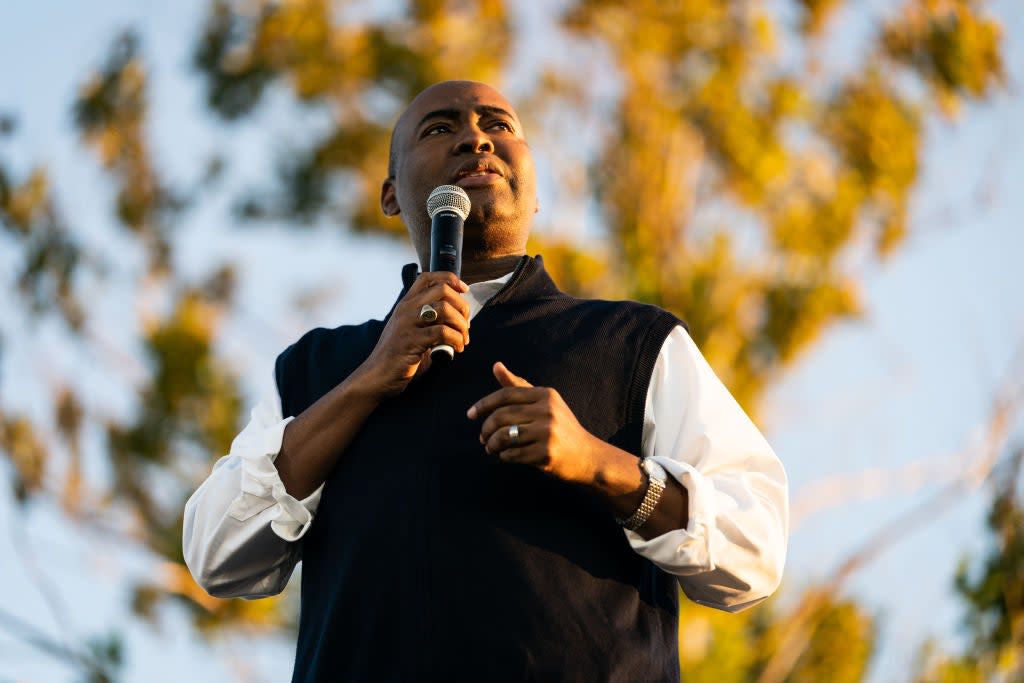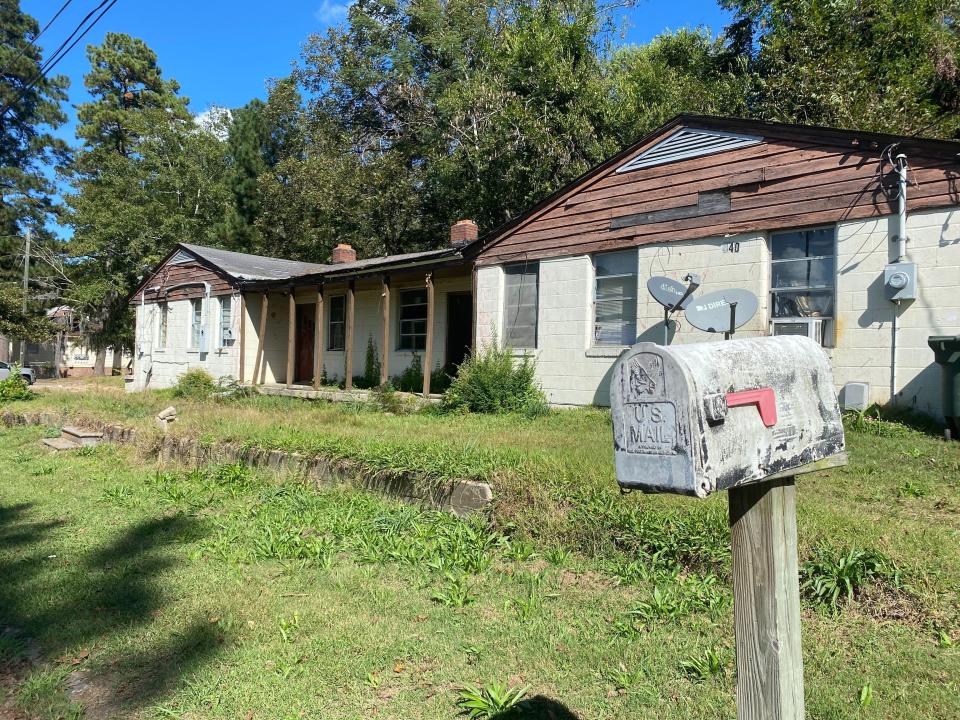In Jaime Harrison's hometown, the weight of racial history bears down on South Carolina Senate race

If you’re driving eastward into Orangeburg, South Carolina, along state highway 301 — known along this strip as John C Calhoun Drive after the state’s iconic pro-slavery senator — the road suddenly forks about three quarters of a mile from town, just past the Edisto River.
Veer left onto Russell Street and you’re on the same route 150 members of the Ku Klux Klan took in 1987 as they marched through the town square, where, since 1893, a statue of an unnamed Confederate infantryman memorialising 195 dead rebel soldiers from the surrounding county has stood watch over a city where three of every four residents are black.
At the crotch of the forked road stands a shuttered retro ice cream shop with blue and white striped window awnings, the Edisto River River Creamery, once proudly advertised as Orangeburg’s “home of the ‘double dog dare!’”
And at the eastern tip of the creamery’s empty parking lot, facing down the street towards the Orangeburg town square on a nearly cloudless, 83-degree Saturday in late October, an 8-by-12 foot Confederate battle flag lifts and falls on a warm, lazy southern breeze.
The owner of the creamery had crusaded for years to remove the flag, but the lot’s previous owner, Maurice Bessinger, a South Carolina barbecue restaurant mogul and avowed white supremacist, had severred the 0.003-acre corner of the parking lot — roughly the size of a hotel kitchenette — from the rest of the plot and sold it to a local chapter of the Sons of Confederate Veterans.
“We still have a long way to go,” state Representative Jerry Govan, a lifelong Orangeburg native, said of his city.

The racial history in Orangeburg, the seat of the most reliably Democratic-voting county in all of South Carolina for decades, is inescapable.
And with so many relics from the past still there, it’s a living, breathing history.
The rebel flag on the edge of the creamery parking lot. The Confederate monument in the town square.
The old, abandoned county jail known locally as the “Pink Palace,” where police in the 1950s and 1960s would book and hold students from nearby HBCUs Claflin College and South Carolina State University who orchestrated sit-ins at segregated lunch counters and other non-violent acts of protest.
Out of this city, which locals hail as the forgotten birthplace of South Carolina’s civil rights movement, emerged Democratic Senate candidate Jaime Harrison, raised in Orangeburg by a single black mother and her parents in what is now a dilapidated ranch-style home of chipped, white-washed cinder blocks and rotting wooden top-paneling.

It’s a story Mr Harrison tells at virtually every campaign stop, including most recently in Florence, South Carolina, about halfway between the state capital of Columbia in the west and Charleston on the coast.
He was working late one night at the US Capitol in Washington a few years back, where he was a mid-level aide for House Minority Whip Jim Clyburn, who represents Orangeburg and lives in the county.
A woman on the Capitol custodial staff stopped by his office late one night and said she had cleaned his office several times before. She’d always noticed the pictures of Mr Harrison and his mother.
Meeting Mr Harrison for the first time, she asked him if he was from South Carolina.
Yes, he said.
Orangeburg?
Another yes.
Was that a picture of his mom on the wall?
Uh huh.
Was his mother’s name Patricia?
It sure was.
Patricia Harrison?
Yes, that’s his mother — Patricia Harrison of Orangeburg, South Carolina.
“Oh my god,” the woman said, raising a trembling hand to her mouth.
“I know your mother. I went to high school with your mom. I remember when your mom dropped out of school to have you,” she told Mr Harrison.
Hometown kid
The story encapsulates Mr Harrison’s pitch that has resonated with voters this cycle, especially black, rural voters, that he is one of them and Senator Lindsey Graham, the Republican incumbent, is not.
It’s classic campaign strategy: Paint the incumbent as out-of-touch with people from their state, drunk on power from being in Washington too long. (In Mr Graham’s case, 25 years as a US House member or senator.)
But in South Carolina — the first state to secede from the Union during the US Civil War, where roughly three in 10 residents are black, where relics of Jim Crow dominate majority-black cities like Orangeburg, and amid a new national wave of racial justice protests sparked by the police killings of George Floyd, Breonna Taylor, and others — that hometown-black-kid-versus-the-white-incumbent-DC-fat-cat narrative has carried a deeper resonance.
Mr Graham’s embrace of Donald Trump cuts to the heart of Mr Harrison’s campaign.
A deep disdain for Mr Trump pervaded interviews with several Democratic leaders and voters in Orangeburg this past weekend, stoked by the president’s equivocation on white nationalist violence in Charlottesville and refusal to denounce white supremacy on a debate stage in September.
“For a good part of his career, Lindsey Graham seemed to be going in the right direction,” said Cecil Williams, 82, a photographer of the civil rights movement in Orangeburg and elsewhere in the South during the 1960s.
Despite being a Republican, Mr Graham for years had earned the respect of many black South Carolinians for his bipartisan deal-brokering and disavowal of the Palmetto State’s racist history, first in the statehouse in the 1990s and then in Washington.
“Lindsey was what we called one of the good ones,” said Mr Govan, who chairs the South Carolina general assembly’s 44-member black caucus and was first elected to the state legislature in the same year as Mr Graham in 1993.
“He was a decent man. He called a spade a spade” even if that sometimes ruffled other Republican feathers at the statehouse, Mr Govan said.
That changed after Mr Trump’s election.
Mr Graham “latched onto the coattails of Donald Trump” to stave off a primary challenge from the right, a move for which black South Carolinians could not forgive him, Mr Williams told The Independent in an interview on a side patio of the civil rights museum he has built next to his house in Orangeburg to showcase the city’s racial history.
Mr Graham’s sprint towards Mr Trump succeeded by ensuring victory in the state’s GOP primary in June, but it has exposed him to broadsides from Mr Harrison’s campaign that he is a serial flip-flopper, most glaringly on his unflinching support for Mr Trump in 2017 after calling him a “race-baiting, xenophobic, religious bigot” just months earlier.
Dead heat
Recent polls have shown Mr Graham and Mr Harrison virtually tied and some prominent election handicappers have rated the race a Tossup, although FiveThirtyEight still gives Mr Graham an 80 per cent edge to win in its simulations forecast.
Every major theme of Mr Harrison platform appears tailored to cities, like Orangeburg, in the rural black centre portion of the state, which Mr Govan called the “Diabetes/Cancer/Stroke Belt” of the US.
The top item on Mr Harrison’s agenda is preserving Obamacare, which Mr Graham has voted to repeal on several occasions, and urging state lawmakers to accept the feds’ offer to expand Medicaid there to drive down health care premiums and drug costs for poor people.
He is also pushing a plan to invest billions of federal dollars in universal broadband internet infrastructure so rural communities can get online and keep up with their urban neighbours.
The coronavirus pandemic, which has flooded hospitals with patients and kept children at home for remote learning, has only served to amplify those health care and internet connectivity needs, local leaders have said.
“Covid pulled the wool off people’s eyes” about the health care issues and hospital access concerns that have been afflicting poor South Carolinians for years, Mr Govan said.
Mr Harrison also supported congressional Democrats’ bill from this summer that would reform law enforcement practices in the US, including banning no-knock warrants and chokeholds and creating national registries for police violence and other misconduct.
South Carolina’s junior Senator Tim Scott, the only black Republican in that chamber, drafted a GOP counter-proposal panned by Democratic vice presidential nominee Kamala Harris as too “hollow.”
Neither piece of legislation has gained traction among the opposite party, but Democrats will be eager to deliver results on criminal justice reform if they can take back the White House and Senate and can keep the House this election cycle.
Senate Democrats need to pick up a net of four seats (or three seats plus the presidency) to reclaim the majority in November, and the Graham-Harrison race has become one of cycle’s most smoldering battlefields.
Mr Graham has framed his campaign as a fortress against Mr Harrison and the Democrats’ “radical” agenda, saying his opponent and Democratic presidential nominee Joe Biden are Trojan horses for a socialist agenda from left-wing radicals overtaking the more moderate Democratic establishment in Washington.
At the lone South Carolina Senate debate on 3 October, Mr Graham framed the race as a choice between “capitalism versus socialism,” “conservative judges versus liberal judges,” and “law and order versus chaos.”
A ‘new generation’
In a city like Orangeburg with so much racial history — where the 1968 massacre in which local highway patrol officers fired on protesters on the knoll at SCSU, killing three students and wounding 28, is deeply etched into the memories of many older residents — it’s the renewed political activity of South Carolina’s young people who give local leaders hope.

Students from Claflin and SCSU have always been the “foot soldiers” of the civil rights movement in Orangeburg, Mr Govan said.
But local students’ and young people’s activism has now extended past the fight for basic civil rights such as voting access and racial integration and incorporated more elements of the economic justice and equality movement.
“This generation doesn’t see or feel that things have to be how they’ve always been,” Mr Govan said. “This generation doesn’t see a racial divide. It sees a [class] division between the haves and the have-nots.”
The state lawmaker said it has heartened him to see how young people in Orangeburg have mobilised behind Mr Harrison, their hometown Senate candidate with an energy and vigor that has been missing for nearly decades.
And while Mr Govan, a minister by trade, said black churches are still the political backbone for the Democratic party in the state, especially among older people, the information age has helped usher in a new era of social awareness and political activism among young blacks.
“Young people may not carry bibles,” he said. “But they do carry cell phones.”
Even in Orangeburg, though, progress is a crawl.
In 2013, the city elected its first black mayor.
At the ice cream parlor at the juncture of Russell Street and Calhoun Drive greeting people as they head into town, the Confederate flag still flies.
“Those kinds of symbols that you see … exist in numerous locations all across the South,” Mr Govan said.
“That is the challenge for this next generation. How will they address it?”
Read more
Harrison delivers final anti-Lindsey Graham pitch to South Carolina
The question Jaime Harrison isn’t answering in his race against Graham
Jaime Harrison spent a record $57 million to unseat Lindsey Graham
The vulnerable Democrat in Trump country who is key to Pelosi’s plans
Fox host slams Senator Lindsey Graham just days before the election

 Yahoo News
Yahoo News 
